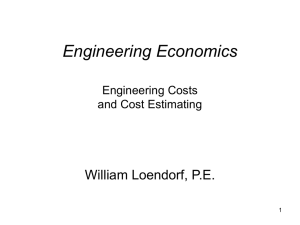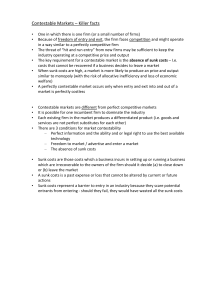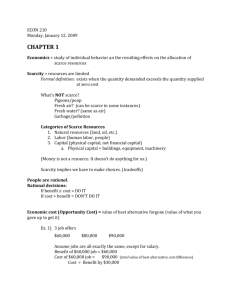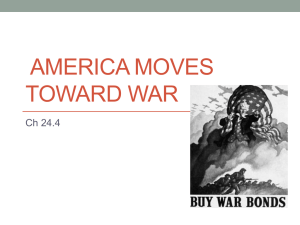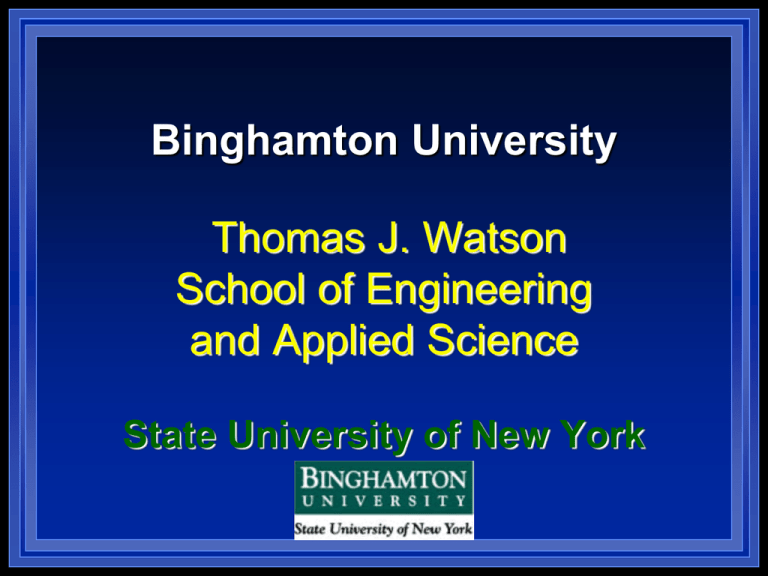
Binghamton University
Thomas J. Watson
School of Engineering
and Applied Science
State University of New York
WARNING
All rights reserved. No part of the course materials
used in the instruction of this course may be
reproduced in any form or by any
electronic or mechanical means, including the use
of information storage and retrieval systems,
without written approval from the copyright owner.
©2006 Binghamton University
State University of New York
ISE 211
Engineering Economy
Engineering Costs
(Chapter 2)
Engineering Costs (CHAPTER II)
Evaluating a set of feasible alternatives requires that many costs
analyzed.
Examples: initial investment, new construction, facility modification,
general labor, parts and material, inspection and quality, material
handling, overhead costs.
Classification of costs:
Fixed, Variable, Marginal, and Average costs
Sunk costs
Opportunity costs
Recurring and Non-recurring costs
Incremental costs
Cash costs Vs. Book costs
Life-cycle costs
Fixed, Variable, Marginal, and Average costs
Fixed costs: constant (unchanging) regardless of the level of output
or activity.
Variable costs: depend on the level of output or activity.
Marginal cost: the variable cost for one or more unit.
Average cost: total cost divided by the number of units.
Example: A production environment
fixed costs:
variable costs:
Example 1
Let’s say:
Fixed cost is $50, variable cost is $1 per unit
If we make 10 units:
Total cost is $60
Average cost is total cost/number of units:
$60/10=$6 per unit
Marginal cost is the extra cost if we increase our
production by 1 unit: $1 per unit
Example 2
An entrepreneur named DK was considering the money-making potential
of chartering a bus to take people from his hometown to an event in a
larger city. DK planned to provide transportation, tickets to the event, and
refreshments on the bus for those who signed up. He gathered data and
categorized these expenses as either fixed or variable:
DK’s fixed costs
DK’s variable costs
Bus rental
$80
Event ticket
$12.5/person
Gas expense
$75
Refreshments
$7.5/person
Other fuels
Bus driver
$20
$50
Develop an expression of DK’s total fixed cost, total variable cost, and
total revenue for chartering this trip.
Example 2 Solution
Example 2 (cont’d…)
Figure 1: Fixed, variable, and total costs
Example 2 (cont’d…)
Figure 2: Profit-loss breakeven chart
Sunk Costs
A sunk cost is money already spent due to past decisions.
Sunk costs should be disregarded in engineering economic analysis
– current decisions cannot change the past.
Example: money spent last year to purchase new production
machinery.
Why is sunk cost always irrelevant?
Decisions between alternatives should be made on the basis of
their differences
All identical factors can be canceled out
Sunk costs have already been spent:
Will be the same regardless of what you do
Can be ignored in making that decision
Sunk Costs (cont’d…)
How should you take sunk cost into account?
To learn why it went wrong for future decisions
Example:
You should ignore sunk costs in deciding whether to finish a
half-completed project
Study them to learn:
Why your project went wrong
How to avoid similar problems in the future
Opportunity costs
An opportunity cost is cost incurred by choosing to do one thing with
your resources instead of doing another.
Examples:
Say a person wants to go to Mexico for Spring Break, taking one
week off from their part time job. By doing so, it costs them the cost
of the trip plus the lost wages.
The assembly line at a manufacturing facility could be used to
produce product B, and the parking lot could be rented out, or used
as a building site, etc, which will provide benefits to the company.
Example
A distributor of electric pumps must decide what to do with a “lot” of
electric pumps that was purchased 3 years ago. Sooner after distributor
purchased the lot, technology advances were made, which made the
pumps less desirable to customers. The pumps are becoming more
obsolescent as they sit in inventory. The pricing manager has the
following information:
Distributor’s purchase price 3 years ago
$7,000
Distributor’s storage costs to-date
1,000
Distributor’s list price 3 years ago
9,500
Current list price of a “lot” of new-pumps
12,000
Amount offered for the old pumps from a buyer 2 years ago
5,000
Current price that the lot of old pumps it could be sold for
3,000
What would be your advice on the price?
Recurring and Non-Recurring Costs
Recurring costs refer to any expense that is known, anticipated, and
occurs at regular intervals. Examples: rent, car payment, regular
payment, etc.
Non-Recurring costs are one-of-a-kind and occur at irregular intervals
-- difficult to plan for or anticipate from a budgeting perspective.
Examples: replacing equipment, ending/starting production of a
product, emergency maintenance expense, etc.
Anticipated costs, whether recurring or non-recurring costs can be
modeled / handled easily in engineering economic analysis, as cash
flows that occur at regular or irregular intervals (e.g., every year or every
five years).
Incremental Costs
Differences in costs between two alternatives – how much more or
less does one cost than the other.
Example: Philip is choosing between model A (a budget model) and
model B (with more features and a higher purchase price). What
incremental costs would Philip incur if he chose model B instead of the
less expensive model A?
Cost Items
Model A
Model B
Purchase price
$10,000
$17,500
Installation costs
3,500
5,000
Annual maintenance costs
2,500
750
Annual utility expenses
1,200
2,000
Disposal costs after useful life
700
500
Cash Costs Vs. Book Costs
A Cash cost requires the cash transaction of dollars “out of person’s
pocket” into the “pocket of someone’s else”.
Cash costs and cash flows are the basis of engineering
economics.
Book costs are cost effects from past decisions that are recorded “in
the books” (accounting books) of a firm – they do not require transaction
of dollars.
Book costs do not ordinarily represent cash flows and thus are not
included in engineering economics.
Exception: the impact of asset depreciation on tax payments –
which are cash flows included in after-tax analyses.
Life-cycle Costs
Life-cycle costs refers to the costs associated with the various phases
of a product/goods/services life cycle.
Typical life-cycle of products, goods, and services.
Cumulative life-cycle costs committed and dollars spent
Life-cycle design change costs and ease of change
Cost Estimating
We cannot always know exact costs ahead of time – need to
estimate.
Different methods will lead to different estimates – uncertainty.
Types of Estimates
1) Rough estimates
The accuracy of rough estimates for initial values/feasibility
is -30% to +60% -- humans tend to be optimistic.
2) Semi-detailed estimates
Used for budgeting purposes at the preliminary design
stage
-15% to +20%.
Cost Estimating (cont’d)
3) Detailed estimates
Used for detailed design and contract bidding phases
Based on detailed quantitative models: blueprints, vendor
quotes, product specification sheet, etc.
-3% to +5% accurate.
Cost more to develop b/c they take more to develop.
Cost Estimating (cont’d)
Why is estimation difficult?
One-of-a-kind projects -- Space station, Hoover Dam
Time and effort available -- the more detail needed, the
more time and effort required.
Estimator experience – the more you estimate and then
see how the true values come out, the better you become.
How to build experience without estimating things wrongly?
Mentors
Auditing past experience
Starting on small projects
Review meetings
Estimating Models
1. Per Unit Model
Uses a “per unit” factor, times the number of units to
determine the total costs.
Simple – provides rough estimates.
Ignores economies of scale (higher quantities cost less on
a per unit basis
Used often in the construction industry.
Example
Use the per unit model to estimate the cost per student that you will incur for hosting 24
foreign exchange students at a local island campground for 10 days. During camp you
are planning the following activities:
2 days of canoeing
3 days hiking
3 days at the lake beach
Nightly entertainment
After calling the campground and collecting other information you have accumulated the
following data:
Van rental (per person, one way, and plus gas): $50/15 person
van
Camp is 50 miles away, van gets 10 mpg, and gas is $1 per
gallon
Cabins at the camp hold 4 campers, rent is$10 per day per cabin
Meals are $10 per day per camper (no outside food is allowed)
Boat transportation to the island is $2 per camper (one way)
Insurance/grounds fee/overhead is $1 per day per camper
Canoe rental are $5 per day per canoe (canoes hold 3 campers)
Day hikes $2.5 per camper (plus cost of meals)
Beach rental is $25 per group per ½ day.
Nightly entertainment is free!
Estimating Models (cont’d)
2. Segmenting Model
Described as “divide and conquer”.
Was used in previous example to break total estimates into
smaller and smaller pieces: travel, living, etc.
3. Cost Indexes
Numerical values that reflect historical change in
engineering costs (and others).
Dimensionless, and reflect relative price change in either
individual items (labor, material, etc) or group/aggregated
of costs (consumer and producer prices).
Cost at time A
Index Value at time A
Cost at time B
Index Value at time B
Example
Miriam is interested in estimating the annual labor and material costs for
a new production facility. She was able to obtain the following labor
and material cost data:
Labor Costs:
Labor Cost Index values at 124 ten years ago and is 188
today
Annual labor costs for a similar facility were $575,500 ten
years ago
Material Costs:
Material Cost Index values at 544 three years ago and is
715 today
Annual Material costs for a similar facility were $2,455,000
three years ago


